Stories From Our Past
Wayne Staab, PhD is one of my coeditors at www.HearingHealthMatters.org and other than being involved in almost every technological development since the 1970s, Wayne likes to dig into the past of our profession. Here are two successive blog posts about hearing aids from the first PSAP in 1948 and onwards.
– Marshall Chasin, Editor
Old Hearing Aids – What is Your Story?
While searching the garage the other day for a baling hook, I found a box titled “old hearing aids.” I wondered how old some of these might be, and if there were any interesting features/design characteristics. And, why did I keep these?
A number of photos of old hearing aids can be found in the literature, but usually don’t provide enough information to show the ingenuity that went into some of them. Some are just interesting enough either because of the technology involved, or just because they are rare, that it would be unfortunate to circular file my old hearing aids before providing information somewhere on them.
I did find old hearing aids and some that were interesting. This post describes a few of them and shows where they fit into the historical development of hearing aids. This was done without going into a full search of the companies who manufactured them, knowing that most of them no longer exist. But, these were the cream of the crop in their hay day! (No pun related to the baling hook). These are hearing aids people actually wore, not experimental models.
This, and perhaps a couple of posts that follow, will feature some of these products and try to put them into their historical perspective.
Hand-Held Hearing Aid – The First PSAP?
Aurex “P-A” (Personal Amplifier) 1948
This was a 3 vacuum tube, hand held amplifier with a rubber eartip encased in a small trumpet-like device (Figure 1).
It was powered by two batteries (RM-3, 1.4 volt mercury “A” battery and a 15 volt No. 411 “B” battery). It was advertised as useful for normal hearing persons at concerts, etc. Dimensions were 114 mm long x 38 mm in diameter. An On/Off switch combined with a volume control was just below the upper golden rim. The microphone was at the bottom of the device and covered by a felt material. I suppose that this could be called a precursor to current day PSAPs (Personal Sound Amplification Products) based on the recommended use. It was advertised for use at concerts by people with normal hearing, but certainly would have helped hearing-impaired individuals as well.
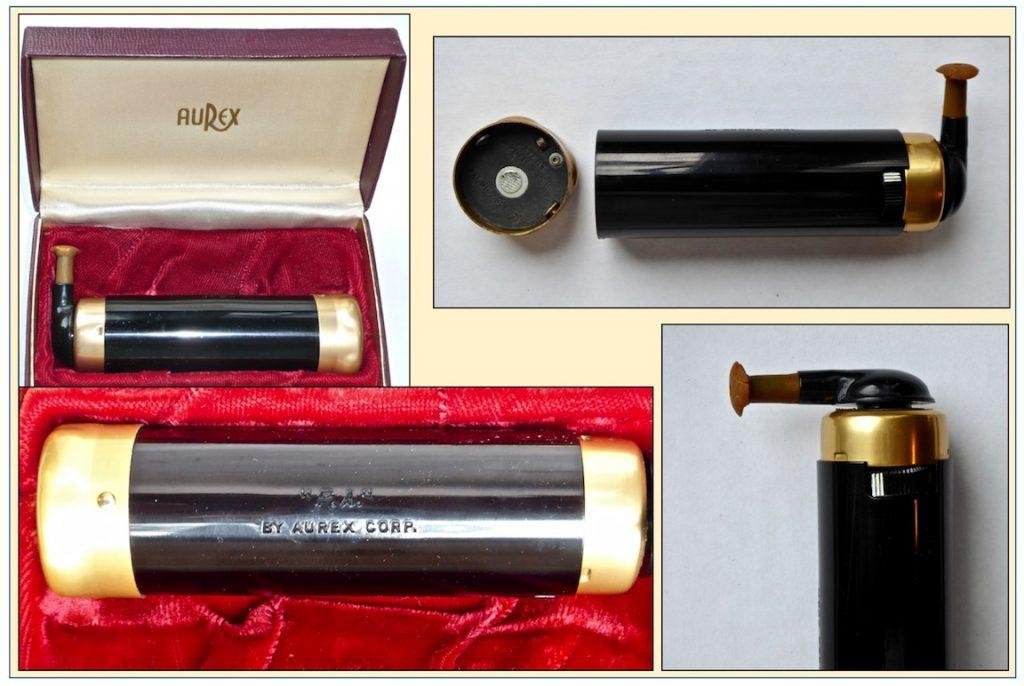
Figure 1. Aurex “P-A” (Personal Amplifier). It was advertised for use at concerts by individuals with normal hearing, but certainly would have helped those with hearing loss as well.
Aurex was established in Chicago in 1935 by Walter Henry Huth. Aurex manufactured group hearing aids, and in 1939 their first wearable hearing aid. They produced early sub-miniature vacuum tubes, and were one of the first companies to use “prescription fitting” by making use of a series of switches in the hearing aid.
1950s – Introduction of Three New Types of Hearing Aids
Figure 2. Comparison in size of vacuum tube (left) to transistor (right). This, along with the other advantages of transistors, contributed to size reduction in hearing aids.
However, all this changed with the introduction of the transistor amplifier in the early 1950s. These were very small compared to vacuum tubes and required only a single battery having much lower voltage, meaning that the power supply was smaller as well (Figure 2). Body-worn hearing aids were among the first to use transistors (starting in about 1953), and with this, hearing aid evolution took a major step forward. The 1950s saw the introduction of eyeglass, behind-the-ear, and in-the-ear hearing aids (in that order) – all resulting from the use of transistor technology.
Body-Worn Hearing Aids
Still, prior to, and even into the early part of the transistor era, body-worn hearing aids showed continued improvements, primarily in size and power supply reduction. It helped that the microphone and receiver/speaker were being reduced in size as well. I found many models of body worn hearing aids in the box. It would require too much space to feature all of these. Therefore, I decided that I would feature just a couple that were truly different.
Telex 300 (1950)
This 1-piece pen-style hearing aid (prior to the transistor), was essentially a body-worn hearing aid disguised as a fountain pen (Figure 3). It housed 3 vacuum tubes, used a printed circuit, and was powered by two batteries (RM1 and a 505). The case was made of metal, 140 mm long and 18 mm om diameter. Weight was 2.5 oz. without the batteries. The microphone was on the pocket clip, the volume control was on the top, and a two-prong cord delivered the amplified signal to the ear via an external receiver. An ad for the new style hearing aid is shown in Figure 4.

Figure 3. Telex Pen-style hearing aid using 3 vacuum tubes. The microphone is incorporated into the clip-on attachment on the upper part of the aid.

Figure 4. An ad for the new pen-style hearing aid by Telex in 1950, the Model 300.
Telex was established in 1936 in St. Paul, Minnesota by Allen Hempel (previously with Acousticon and Aurex) as Telex Products Co.
Eyeglass Hearing Aids
Most hearing professionals have only a vague idea about eyeglass hearing aids and believe that they were little used. This is quite to the contrary. In fact, Sam Lybarger has indicated that eyeglass hearing aids preceded behind-the-ear (BTE) amplification devices and were developed independently.1 From about 1954 until the mid 1970s, eyeglass hearing aids had a reasonable share of the hearing aid market, especially replacing some body-worn aids during the earlier years of this time period. With the employment of the transistor, eyeglass hearing aids served as an independent step between body-worn hearing aids and BTE products. A discussion of how they served this role was the subject of a previous post. Eyeglass hearing aids lost favor for a variety of reasons, but primarily because of the expansion of lightweight eyeglasses. It became essentially impossible to inventory all the styles, hinge varieties, colors, etc. for frames and temples. I recall in about the mid 1970s, at Audiotone, we threw out thousands of hinge adaptors because none fit the newer thin frames of hearing aids and the decision was made to design no new eyeglass hearing aids. Amplification could be better managed without such complications using BTE units.
Barrette Hearing Aids
Figure 5. Barrette-style hearing aids served as a step between eyeglass transistor hearing aids and behind-the-ear hearing aids. They essentially incorporated the features of body-worn aids and an external receiver, which was connected by a cord (receiver not shown in image).
Sonotone 79 (1955)
This hearing aid was used either as a barrette or BTE hearing aid according to Sonotone (Figure 6). It used an external receiver. It was a 3-transistor amplifier and was powered by a 625 cell. The case was plastic, with dimensions of 46 x 32 x 16 mm. Sonotone suggested that this might represent the first behind-the-ear hearing aid2. However, because the receiver was detached and not integrated into the housing, this author is more likely to place it into the Barrette/body-worn category, but one that made the transition from vacuum tubes to transistors. The fact that it is difficult to imagine this being placed behind the ear, with the receiver cord attached on the left extended portion, makes it difficult to imagine this as being a true behind the ear instrument – other than attached somewhere to the hair behind the ear, and then the cord going to the ear. In reality, this is a barrette hearing aid.

Figure 6. Sonotone 79 transistor hearing aid of 1955. Sonotone promoted it as a barrette-style hearing aid, but they also left open their belief that this might be the first behind-the-ear hearing aid. The cord arrangement to the left side of the instrument would seem to make it difficult to fit behind the ear. It is basically a barrette hearing aid. Not shown is the barrette attachment on the back side. The cord could be attached either at the top or bottom of its attachment to the aid, depending on the ear to which it was fitted.
References
- Lybarger, S. (1989). Unpublished presentation at the Mayo Clinic, Rochester, MN, March 25.
- Berger, K. (1970). The Hearing Aid and its Development. National Hearing Aid Society, Livonia, MI.
The views and opinions expressed in posts do not necessarily state or reflect those of Hearing Health and Technology Matters. Copyright © Hearing Health & Technology Matters, LLC. 2017. Used with permission by Wayne Staab and Hearing Health Technology Matters. Originally posted Sept 12, 2017.
The First BTE Hearing Aids? Old Hearing Aids – Part 2
Last week’s post revolved around finding a box of old hearing aids in my garage, and wondering if any of them were interesting or rare enough that information and photographs of them should be documented.
I found some really good “stuff” and wrote about some unusual hearing aids that I had found in the box. That post focused on some of the early eyeglass hearing aids and where they fit into the historical development of hearing aids. I ended by saying that this week’s post would continue this historical trend, but would focus primarily on the origins of the first BTE hearing aids.
BTE Hearing Aids
Behind-the-ear (BTE) hearing aids dominated the hearing aid market during the 1960s and 1970s (with a resurgence in the late 1990s and continuing until now). Transistors, replacing the vacuum tubes as amplifiers, allowed substantial, but not all, of the miniaturization that occurred in just a very short time following their use in hearing aids, and allowed smaller devices that could be fitted where they belonged – at the ear level. The change in size reduction was limited somewhat in the early days because microphones and receivers were still rather large. Adding to the size during this evolutionary period was that most of the components – transistors, resistors, capacitors, switches, etc. were connected via soldered hard wire.
BTE Early Phases
In the late 1950s, BTE hearing aids were developed in essentially a two-event progression. The first phase involved the use of an external receiver coupled to an earmold to deliver sound to the ear. A second phase in this historical development incorporated all of the hearing aid components into a single case, including the receiver.
BTE With External Receiver
Zenith “Diplomat” (1956)
This hearing aid was among the first to be considered a true BTE hearing aid. During this phase, BTE hearing aids consisted of a processor that fit behind the ear (auricle), and had a hard-wired connection to an external receiver that snapped to an earmold in the ear. In other words, manufacturers took the concept of small body-worn and barrette-style hearing aids that used external receivers, and attempted to implement them at the ear level without lengthy connecting cords (Figure 1).
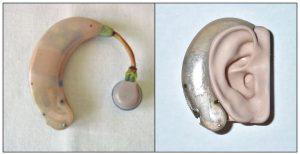
Figure 1. Zenith “Diplomat” hearing aid developed in 1956. It covered the entire area behind the auricle, from top to bottom (and a little beyond), as shown in the right image. The right image does not show the external receiver.
The Zenith Diplomat Behind-the-Ear hearing aid is considered by many to be the first true BTE hearing aid – something that actually was designed to fit behind the ear. It was made by the Zenith Radio Corporation, used four transistors, and had an external receiver. The case measured 64 x 19 x 11 mm and weighed 15 grams. It came in flesh or light gray color. It was often referred to as the “Banana” because of its large size. It used a No. 675 mercury battery. The model from my collection had seen better days as can be seen in Figure 1 on the right side, and no longer had the external receiver that could be unplugged from the hearing aid (a 1957 improvement), not just from the receiver (this feature was a first). In 1959 Zenith introduced the “Diplomat 5” which had a similar appearance, including an external receiver, but used a magnetic microphone and was slightly smaller (56 x 16 x 10 mm but also with a weight of 15 grams). I do have this complete unit, but loaned it to someone for patent work and it has not yet been returned. It had a microphone opening on both sides and was powered by a 675 mercury cell. It came in a peach or gray case.
What a Difference a Year Made
BTE development moved along rapidly. This can be evidenced as seen in Figure 2, showing receiver BTE hearing aids in 1956 (Zenith Diplomat) and 1957 (Dahlberg Magic Ear II).

Figure 2. Zenith Diplomat introduced in 1956 (left aid), and the Dahlberg Magic Ear II introduced in 1957 (right aid). The size reduction in one year was rather remarkable. The Dahlberg aid would fit better on the ear had I chosen to reshape/change the receiver linkage. However, I try not to make any changes on any of the aids in my collection.
Dahlberg Magic Ear II (1957)

Figure 3. The Dahlberg Magic Ear II, a behind-the-ear hearing aid having an external receiver. The case was composed of two different materials. The outer shell was made of metal and the inner surface was a hard plastic. It is speculated that this was done to prevent moisture penetration and rust prevention.
This was a BTE hearing aid having an external receiver. It had 4 transistors, used a 400 size cell, and came in separate right and left ear models because the body had a small outward bend at the mastoid bone to better fit behind the ear. The receiver could disconnect from the processor as well as from the receiver, and the volume control was a round knob at the bottom of the hearing aid. It was 43 x 13 x 10 mm and weighed 10 grams. The case was fabricated of two different materials (Figure 3). The outside was metal and the inside surface was plastic. It was during this time period that many BTE hearing aids were made with metal cases.
BTE Without External Receiver
BTE hearing aids that had all components fully integrated in the hearing aid case was the next logical progression in BTE evolution. These hearing aids had no external receiver, but instead incorporated the receiver into the case along with all the other components. As might be expected, including the receiver into the case had the effect of enlarging the BTE hearing aid, at least in the early stages, making it larger than BTE hearing aids having an external receiver.
Maico AG (1957)
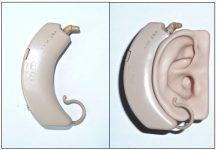
Figure 4. The Maico AG BTE hearing aid having all the components, including the receiver, housed within the case, and showing how it fit individuals. In the images shown in Figure 4, the tubing from the sound outlet nozzle (top extension) to the earmold in the ear, is missing.
This was a three transistor BTE hearing aid that had a lower front hook to hold the hearing aid onto the ear (Figure 4). All components, including the receiver, were incorporated into the plastic case. The aid was powered by a 675 cell. Rough dimensions were 64 x 19 x 14 mm, and the device weighed 19 grams. Weight was measure minus the battery. The volume control was on the bottom and the microphone opening on the back side. It had a two-position switch on the lower back side above the volume control. The outside of the case was metal, and the inside, plastic. Referring to this as a BTE reminds me of the joke: How many elephants can you put in a Volkswagen? Answer: two in the front and two in the back. Interesting, when no constraints are provided.
Sonotone 333 (1957)
This BTE instrument was all metal, and of an unusual shape. It was a 4-transistor hearing aid operated by a 400 cell. Its size was 32 x 21 x 13 mm and weighed 16 grams. The aid was designed to hang over the top part of the auricle (Figure 5). It fit either ear. The battery is under the flap-looking structure between the neck and body of the aid. The microphone opening is the slit at the bottom, just above the Sonotone name and model number.
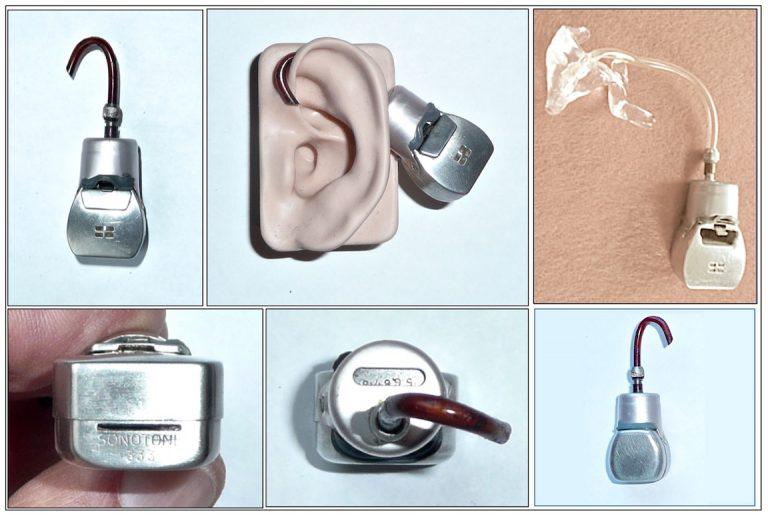
Figure 5. The Sonotone 333 BTE hearing aid. All the components were housed in a metal case. With a longer tubing than shown, the aid would hang down below and behind the lower part of the auricle, not pushed out as shown in the upper center photo. That photo is used primarily to gauge the size. The body was narrower in one dimension than the other, and when fitted with the narrow dimension against the skull, slightly limited the protrusion of the auricle caused by the aid. Again, I did not want to change any of the parts of the aid, including the tubing to the ear. The upper right image shows how it would be attached to an earmold. That image has the batter locker removed. It is held in place by the small latch above the battery compartment opening.
Beltone Minuet (1958)

Figure 6. The Beltone “Minuet” BTE hearing aid. The unit shown is for the right ear (“Right” imprinted into the inner metal plate). It had a large volume control and a separate ON/OFF switch. The microphone opening is in on the lower, outer surface.
The Beltone Minuet was a 3-transistor behind-the-ear hearing aid. It was powered by a 400 cell, had a flesh or gray plastic outer surface and a metal back, and was available as both a right and left side configuration (Figure 6). It measured 54 x 19 x 11 mm. All components were housed in the case, including the receiver.
Acousticon “Privat-Ear A600” (1958)
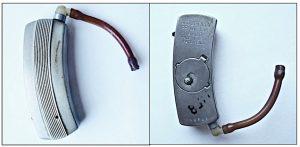
Figure 7. The Acousticon “Privat-Ear” A600 is shown front (left) and back (right). The case is made of metal, both sides. The Acousticon name and model number are shown at the top (right image). The serial number is stamped into the area near the sound tube (right image).
The Acousticon A600 BTE hearing aid was a 3-transistor unit powered by a 675 cell. The entire case was metal, with dimensions of 48 x 16 x 10 mm, and weighing 17 grams (Figure 7). The battery compartment was beneath a metal cover having a slightly-elevated slide knob to open. Additionally, a removable, washer-like inner seal covered the edges of the battery and the battery compartment cover edges to prevent moisture and debris from interfering with power performance.
The views and opinions expressed in posts do not necessarily state or reflect those of Hearing Health and Technology Matters. Copyright © Hearing Health & Technology Matters, LLC. 2017. Used with permission by Wayne Staab and Hearing Health Technology Matters. Originally posted Sept 19, 2017.

